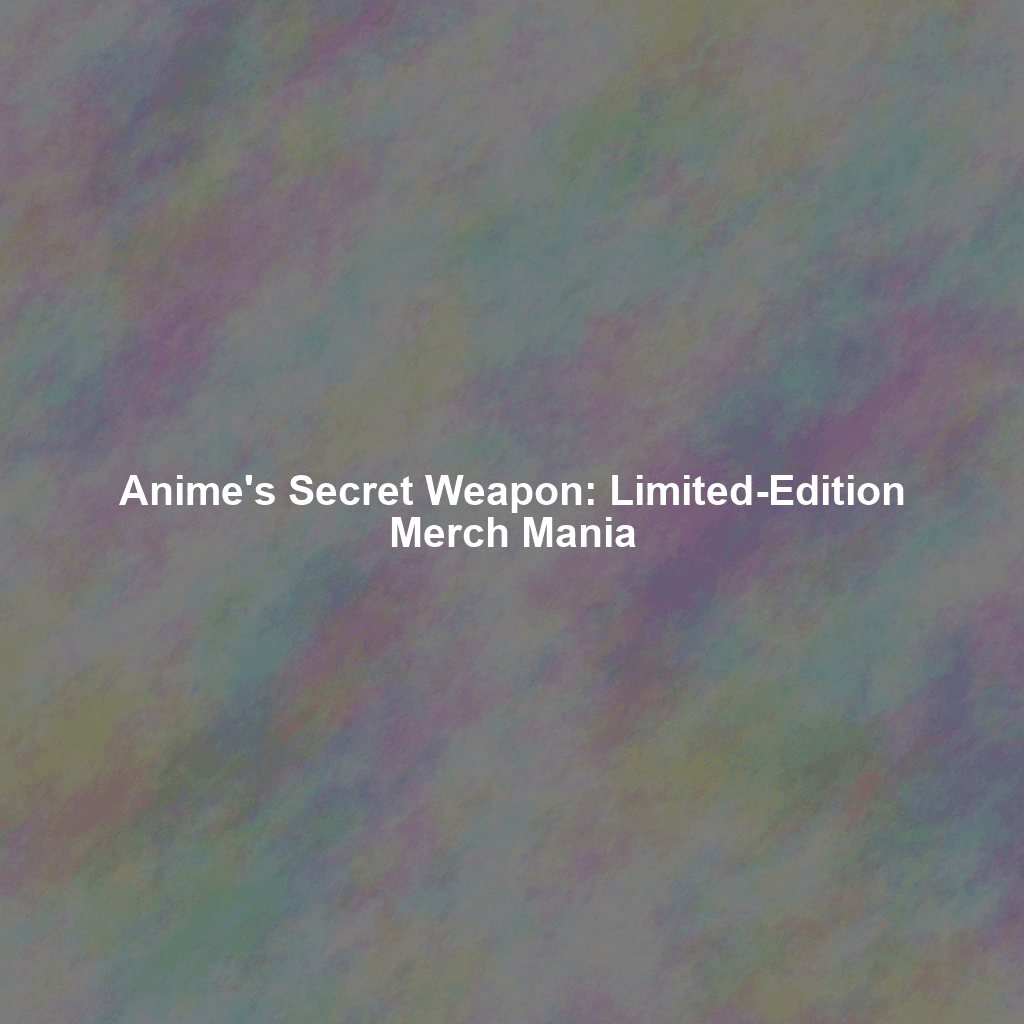The ROI of Fandom: How Strategic Marketing Propelled Anime to Global Phenomenon
Anime’s journey from a niche interest to a global phenomenon is a testament to the power of strategic marketing. While the captivating storylines and unique art style are foundational, savvy marketing tactics have amplified its reach and cultivated a dedicated global fanbase. One of the most effective strategies has been the leveraging of limited-edition merchandise.
The core principle behind the success of anime lies in understanding and nurturing its fandom. Fans aren’t just consumers; they’re active participants in a community, seeking connection, belonging, and ways to express their passion. Limited-edition merchandise perfectly caters to these desires, offering tangible symbols of their dedication and fostering a sense of exclusivity.
The Psychology of Scarcity: Why Limited-Edition Items Work
The allure of limited-edition merchandise stems from fundamental psychological principles, primarily scarcity and exclusivity.
Scarcity: The Fear of Missing Out (FOMO)
Scarcity, a cornerstone of behavioral economics, dictates that people place a higher value on items that are rare or difficult to obtain. This “scarcity principle” triggers a psychological phenomenon known as the “fear of missing out” (FOMO). When fans know that a particular item is only available in limited quantities or for a short period, they are more likely to make an impulse purchase to avoid regret. This is further amplified by social media, where fans share their prized possessions, increasing the visibility of the limited-edition items and driving demand even higher.
Example: A limited-edition figure of a popular anime character, announced with only 1,000 units available worldwide, will likely see a surge in pre-orders due to the inherent scarcity.
Exclusivity: The Desire to Belong and Stand Out
Exclusivity plays on the human desire to belong to a select group and simultaneously stand out from the crowd. Owning a limited-edition item signifies membership in an “inner circle” of dedicated fans. It also provides a sense of personal distinction, allowing individuals to showcase their unique taste and commitment to the anime they love. The rarer the item, the more exclusive it feels, increasing its perceived value.
Example: A special edition Blu-ray box set with exclusive artwork and bonus content, only available to attendees of a specific anime convention, grants owners a badge of honor within the fandom.
Collector’s Value: Investing in Passion
Beyond the immediate satisfaction of owning a desirable item, limited-edition merchandise often holds significant collector’s value. Fans recognize that these items may appreciate in value over time, making them a form of investment, albeit one driven by passion rather than pure financial calculation. This potential for appreciation further incentivizes purchases, especially for items that are carefully preserved and well-documented.
Example: Vintage anime cels (original animation drawings) from classic series can fetch significant prices at auction, representing both a piece of history and a potentially lucrative investment. You can see examples of animation cel values on auction sites like eBay.
Distribution Strategies: Maximizing Impact and Reach
The success of limited-edition merchandise hinges not only on the inherent appeal of the items themselves but also on the effectiveness of the distribution strategies employed.
Pre-Orders: Gauging Demand and Securing Sales
Pre-orders are a crucial tool for assessing demand and securing sales before production even begins. By offering limited-edition items for pre-order, companies can accurately gauge interest, optimize production quantities, and avoid overstocking. Pre-orders also create a sense of anticipation and excitement among fans, further fueling demand.
Actionable Insight: Offer tiered pre-order bonuses to incentivize early purchases and increase the perceived value of the limited-edition item. For example, early pre-orders could receive an exclusive art print or a bonus keychain.
Convention Exclusives: Driving Attendance and Creating Buzz
Anime conventions are prime opportunities to release exclusive merchandise. These convention exclusives drive attendance, create a sense of urgency, and generate significant buzz on social media. Fans are willing to travel and queue for hours to get their hands on these limited-edition items, transforming the acquisition into a memorable experience. Convention exclusives also foster a sense of community, as fans bond over their shared passion and the challenges of obtaining these coveted items.
Example: Funko Pops, particularly those exclusive to San Diego Comic-Con or other major conventions, are highly sought after and often resell for significant markups.
Online Marketplaces: Expanding Reach and Enabling Resale
Online marketplaces, such as eBay, Mercari, and specialized anime merchandise platforms, play a crucial role in both distributing and reselling limited-edition items. These platforms expand the reach of limited-edition merchandise beyond physical events, allowing fans worldwide to participate. They also provide a secondary market for collectors, enabling them to buy, sell, and trade rare items. While companies don’t directly profit from resale, the existence of a thriving secondary market reinforces the value and desirability of their limited-edition offerings. Be mindful of counterfeits, and ensure authenticators are in place where possible. You can also leverage verified seller programs to maintain brand control.
Example: Mandarake, a large Japanese retailer, has both physical stores and a robust online marketplace for buying and selling pre-owned anime and manga goods.
Real-World Examples: Anime Merchandise Success Stories
Several anime franchises have successfully leveraged limited-edition merchandise to drive demand and generate revenue. Here are a few notable examples:
Pokemon: Trading Card Game Rarities
The Pokemon Trading Card Game is a masterclass in scarcity. Rare cards, particularly those from early sets or those with printing errors, can fetch astronomical prices. The artificial scarcity created by limited print runs and the thrill of the chase have made the Pokemon TCG a global phenomenon. The Professional Sports Authenticator (PSA) grades and authenticates trading cards, adding another layer of trust and value to collectibles.
Gundam: Limited Edition Model Kits (Gunpla)
Bandai’s Gundam model kits, or Gunpla, are immensely popular among anime fans. Bandai frequently releases limited-edition Gunpla, often featuring unique color schemes, translucent parts, or exclusive accessories. These limited-edition kits are highly sought after and often command premium prices.
Evangelion: Collaboration Merchandise
The Evangelion franchise is known for its diverse range of collaboration merchandise, from clothing and accessories to figurines and household goods. Many of these collaborations are limited-edition, creating a sense of urgency and driving sales. The brand effectively uses collaborations with high-end fashion brands to generate awareness and demand among a broader audience.
Challenges and Considerations
While limited-edition merchandise offers significant benefits, it’s important to be aware of potential challenges and considerations.
Counterfeiting: Protecting Brand Integrity
The high demand for limited-edition items can attract counterfeiters. Companies must take steps to protect their brand integrity by implementing anti-counterfeiting measures, such as holographic stickers, unique serial numbers, and partnerships with authorized retailers. Educating consumers about how to identify fake products is also crucial.
Scalping: Balancing Profit and Fan Dissatisfaction
Scalping, the practice of buying limited-edition items with the intention of reselling them at inflated prices, can frustrate fans who are genuinely interested in owning the items. Companies can mitigate scalping by implementing purchase limits, using lotteries to distribute highly sought-after items, and actively monitoring online marketplaces for suspicious activity.
Sustainability: Ethical Considerations
The production of merchandise, particularly limited-edition items, can have environmental and social impacts. Companies should consider using sustainable materials, ensuring fair labor practices, and minimizing waste to align their operations with ethical considerations. Communicating these efforts to consumers can also enhance brand image and appeal to environmentally conscious fans.
Conclusion: Leveraging Limited-Edition Merchandise for Long-Term Success
Limited-edition merchandise is a powerful tool for driving demand, generating revenue, and fostering a strong sense of community within the anime market. By understanding the psychological principles at play and implementing effective distribution strategies, companies can leverage the power of fandom to achieve long-term success. However, it’s crucial to address the challenges of counterfeiting, scalping, and sustainability to ensure a positive and ethical experience for fans.
By strategically employing limited-edition merchandise, anime companies can transform casual viewers into dedicated fans, fostering a cycle of engagement that fuels the continued growth and global reach of the anime industry.
 Skip to content
Skip to content

